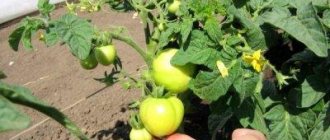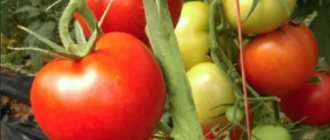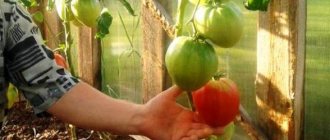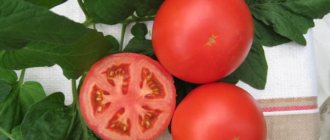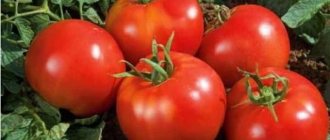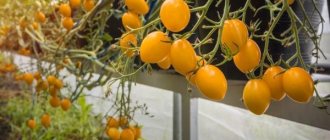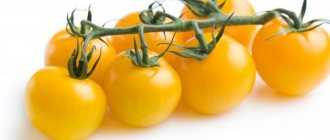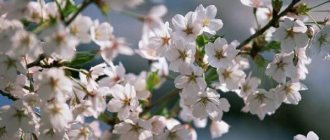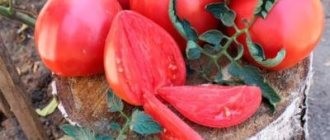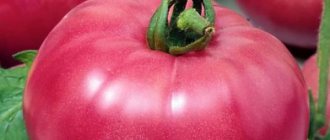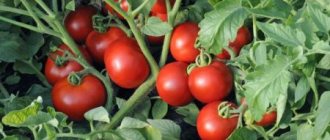Description of tomato variety Red Cherry with photo
The Red Cherry tomato is intended for growing in open ground and under film covers. The variety is recommended for cultivation on both personal and farm plots. Zoned in all regions.
A bunch-type tomato with 20-30 fruits growing in a cluster
The Red Cherry tomato forms a semi-spreading, medium-branched, strong bush more than 2 m tall. The leaves are ordinary, small in size, dark green in color with slight corrugation. The foliage of the stems is low. The inflorescences of the plant are intermediate, the first appears above the 8-9th leaf, the rest - every three.
The type of growth is indeterminate, which means unlimited. It is recommended to grow the bush in 1-2 stems, and the remaining side shoots that appear must be removed in a timely manner. The vegetative development of the plant continues throughout the season, but a few weeks before the end of cultivation it must be forcibly completed. To do this, pinch the stems at the top after the last flower cluster and several leaves.
Advice! Depending on the growing region and the duration of the warm period, it is recommended to leave no more than 10 bunches on the bush.
The Red Cherry tomato has an early ripening period. The harvest begins in the fourth month from the sowing date. When growing, it is necessary to tie it to a support (stakes or trellis).
Description of fruits
The Red Cherry tomato belongs to the small-fruited varieties of the cherry group. One tomato weighs about 15-20 g. Ripens in long beautiful clusters. The fruits have a round shape, a smooth surface, and are red in color when ripe. Tomatoes aligned throughout the bush. Number of sockets – 2-3 pcs. Fresh tomatoes have a sweet taste. And its quality is rated as good and excellent. The skin is prone to cracking.
Description of the variety
Short review:
The growing season of early ripening “Yellow Cherry” is 92-96 days, and of mid-early ripening “White Cherry” - from 100 to 108.
"Cherry yellow"
Fruit:
- Plum-shaped;
- With smooth yellow skin;
- With sweetish aromatic pulp;
- Number of seed chambers - 2-3;
The average weight varies from 15 to 20 grams.
- Average dry matter content;
- Small sizes.
Bushes:
- Indeterminate type, grows in height above 150 cm, not standard;
- Semi-spreading, medium-branched, with average formation of green mass;
- The leaves are small, green in color, with a slightly corrugated surface, without stipules;
- With loose inflorescences of intermediate type.
The formation of the first inflorescence occurs after 8-9 leaves, further ones at intervals of three leaves.
"White Cherry"
Fruit:
- Heart-shaped;
- Beautiful lemon-white color and pink tip;
- With dense, fleshy pulp, milky pink in color;
- With a delicate sweet cherry flavor;
- The average weight varies from 400 to 500 grams.
To the mouth:
- Indeterminate type;
- They reach a height of 180 to 200 cm.
Characteristics of Red Cherry tomato
The Red Cherry tomato is widely zoned and is suitable for the Southern regions when grown in open ground. And also areas with short summers, especially due to early ripening.
Due to the unlimited type of growth, the ovaries on the bush are formed throughout the season. It takes about a month for the hand to mature. Therefore, it is necessary to stop the growth of the stem in time in order to use the plant’s energy to ripen the fruits and accumulate sweetness. But even when picking tomatoes of the Red Cherry variety in an unripe form and ripening them indoors, the taste qualities are preserved.
During the season, the stems can reach 3 m in height
After the formation of the fifth inflorescence, the lower leaves begin to be gradually removed, but no more than 2-3 pieces. in Week. To accommodate a large plant, high greenhouses or cultivation on a horizontal support are necessary. The formation of stepchildren is high, it is necessary to control their growth.
Tomato yield Red cherry and fruiting
The yield of Red Cherry tomatoes in open ground is about 1-2 kg per plant, which is considered a high result, given the low weight of tomatoes. The fruiting of the variety is stable, begins early (95 days from the start of cultivation) and continues throughout the warm season.
The bushes are resistant to adverse weather conditions and form ovaries for a long time and abundantly. To increase productivity, it is necessary to prun the plants in time and not plant them on 1 square meter. m more than 3 pcs. The variety requires intense sunlight.
Area of application of fruits
The Red Cherry tomato is classified as a dessert tomato due to its sweet taste; it is pleasant to eat fresh, including in baby food. The variety is also suitable for canning individual fruits and whole clusters. Due to their decorative properties, fresh tomatoes are used, among other things, to decorate ready-made dishes.
Resistance to diseases and pests
For the Red Cherry tomato, weak resistance to TMV (tobacco mosaic virus) and fusarium is declared. Plants are also highly susceptible to cladosporiosis. They do not have high resistance to late blight. For cultivation, periodic treatments are necessary, but due to the appearance of fruits in the early stages, it is not recommended to use products with a chemical composition. It is better to give preference to biological products.
Pests and diseases
Growing tomatoes is often accompanied by problems associated with the appearance of pests or diseases. Even in greenhouse conditions, tomato bushes are susceptible to most diseases that most often appear when grown in vegetable gardens. Among the diseases, it is worth highlighting late blight, as it often affects bushes. It appears in conditions of high humidity and low temperature.
Bushes infected with late blight gradually turn yellow and dry out.
Among the pests are spider mites, which feed on sap from plant leaves. This insect sucks out all the beneficial microelements from the leaves, causing them to dry out and fall off.
See also
Characteristics and features of growing the Moneymaker tomato variety
Read
The pest loves dry air and therefore appears more often if tomato bushes are not watered enough. To get rid of spider mites, you will have to treat the seedlings with Fitoverm several times.
Advantages and disadvantages of the variety
Tomato Red Cherry is a variety with small beautiful fruits collected in decorative elongated clusters.
The fruits have a universal purpose and look bright in any preparation.
pros
- ripens early;
- unpretentious in agricultural technology, suitable for cultivation even by novice gardeners;
- stable fruiting, good set in different weather conditions;
- the ability to propagate the crop with self-collected seeds.
Minuses
- the taste of the fruit may vary depending on the region and weather conditions;
- for growing, a support device is required;
- low immunity to diseases.
Description and characteristics of the variety
Tomatoes Yellow Cherry from Gavrish are tall indeterminates. Average height is 2 meters or more. The variety is early ripening, from germination to ripening 95-100 days. The plant is powerful, the leaves are dense, slightly corrugated, dark green. The tomato is very leafy, the number of stepsons is small. The variety is intended for cultivation in open areas and in film greenhouses.
The taste of the fruit is highly dependent on the amount of heat, sunlight and nutrition.
The first inflorescences are simple, containing 15-20 tomatoes. The following are complex, branching; 30-40 small round tomatoes simultaneously develop on one brush. A ripe cherry cluster resembles a bunch of grapes, the fruits are small, 15-25 grams each. The skin is bright yellow, dense, and there is a lot of liquid content inside. Ripe tomatoes are sweet and juicy.
Features of cultivation
The Red Cherry tomato is grown in seedlings. About two months are allotted for keeping plants indoors. During this time, 5-7 true leaves should be formed on the stem. Depending on the growing region, sowing is carried out from mid-February to the second half of March.
To grow seedlings, you need to prepare a small container and planting soil. Containers can be either separate or shared. Be sure to have drainage holes to drain excess liquid when watering. Reusable containers are disinfected with antiseptic agents.
The soil for growing needs to be light, with good breathability. To do this, use ready-made or mix peat, humus, ash and river sand yourself. All mixtures must be disinfected to reduce the possibility of fungal diseases that can destroy seedlings.
Important! The soil is treated several days before planting, spilling it with solutions of fungicides or potassium permanganate.
The soil is mixed well, loosened, and large inclusions are removed. The prepared soil must be lightly crushed and moistened. Then shallow grooves are marked and the seeds are laid out at a distance of 3-4 cm. The crops are covered with a light thin layer of soil or soaked coconut substrate on top. Also, everything is lightly crushed, which will allow the sprouts to free themselves from the seed coat.
If the film remains on the sprout and comes out with it to the soil surface, it is carefully removed
To remove the seed coat, it is first moistened with water and removed using tweezers. This is important for the proper development of plants.
Seedlings are picked during the formation of several true leaves. A week before planting in the ground, the plants are hardened off. They are transferred to film greenhouses in mid-May, and to open ground in early June.
Plants are planted in the ground according to a 40 by 60 cm pattern. Immediately after planting, they are tied up. Further care consists of regular watering and several fertilizing depending on the initial soil fertility.
To protect the soil from a crust that disrupts air exchange, as well as to maintain humidity and a special microclimate, it is covered with mulch made of straw or dark agricultural material.
Features of care
Caring for planted tomatoes must be done correctly, since the quality and quantity of the harvest depends on this.
Watering
It is recommended to water the tomatoes regularly so that the bushes always have enough moisture. However, in the first 5–10 days after transplanting into open ground, it is better not to water the seedlings. When they take root in a new place, the soil is moistened 2-3 times a week. On hot summer days, the amount of watering is doubled, since the soil dries out faster at high temperatures.
Loosening
After each moistening of the area, the soil should be loosened to get rid of crust on the surface and weeds. The soil should be loosened to a depth of about 10–12 cm so that enough oxygen enters the top layer of soil.
Top dressing
To get a good harvest, you will have to regularly fertilize the plants. Bird droppings are often used for fertilizing, as it contains all the beneficial microelements that tomatoes need. To prepare a solution for fertilizer, about 450 grams of droppings are added to 10 liters of water.
The opinion of summer residents regarding the “Winter Cherry” tomato
To understand what a certain variety of tomato is, a novice summer resident looks for answers on the Internet. Reviews provide more useful information.
- Hope. A resistant plant, very hardy and unpretentious. Many tomatoes died from tobacco mosaic. The “Winter's Tale” tomato survived and produced flowers and fruits. The yield is not bad.
- Valentina. This was my first time trying to plant this type of tomato. Everything turned out great. The tomatoes went especially well in jars for pickling. The description was completely confirmed. The tomato is worthy of praise.
Summer residents appreciate “Winter Cherry” tomatoes for their unpretentiousness and the low amount of physical effort required to care for the bushes. There is no need to spend extra time shaping and tying up the plant. And the taste qualities are left behind by some varieties of tomatoes.
